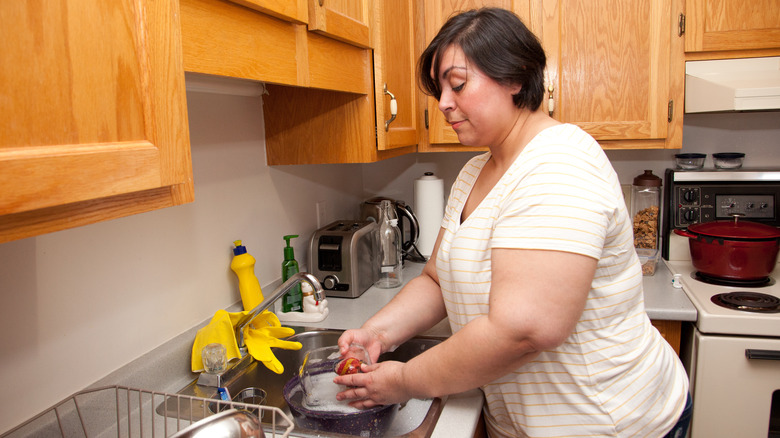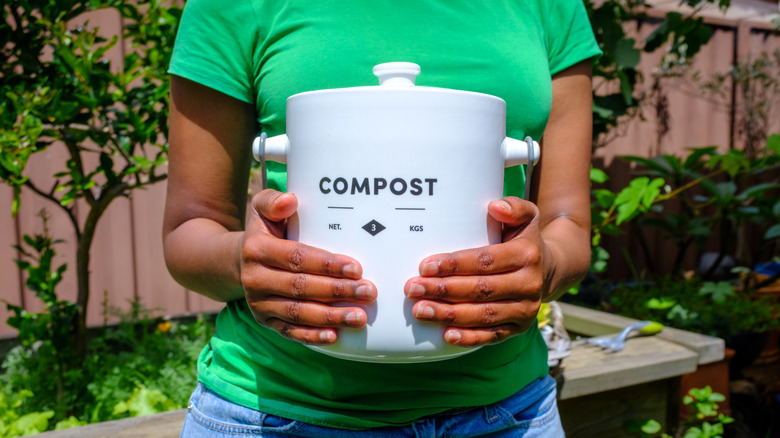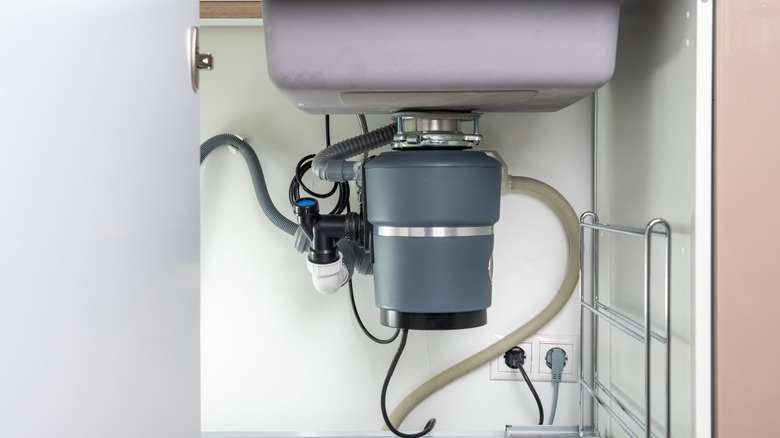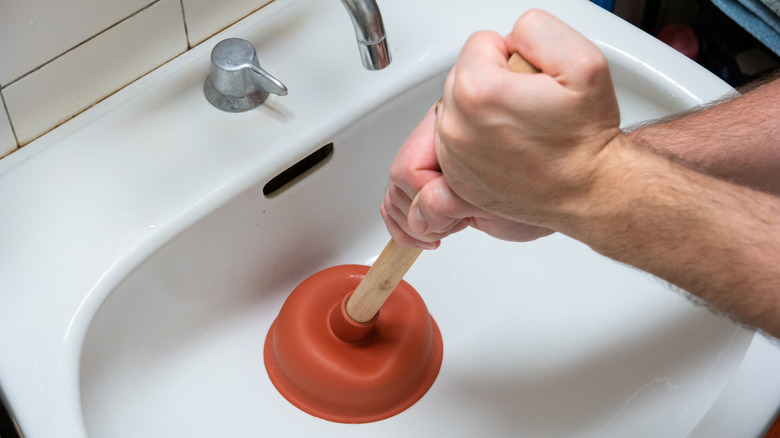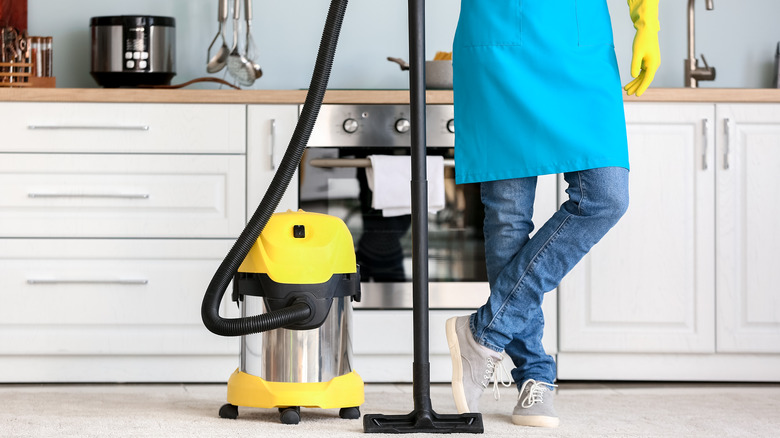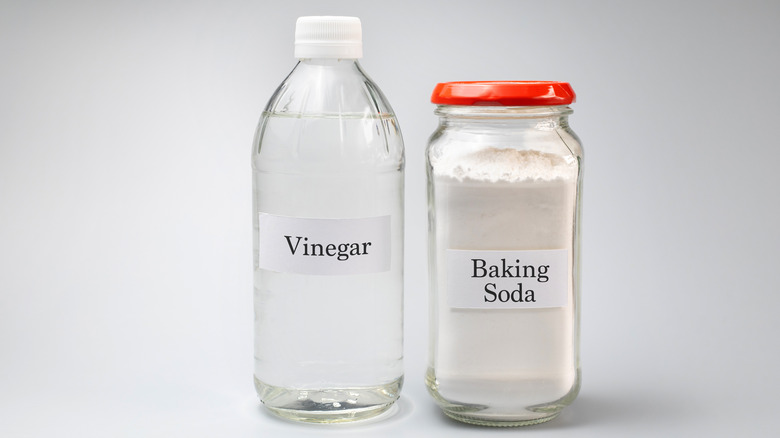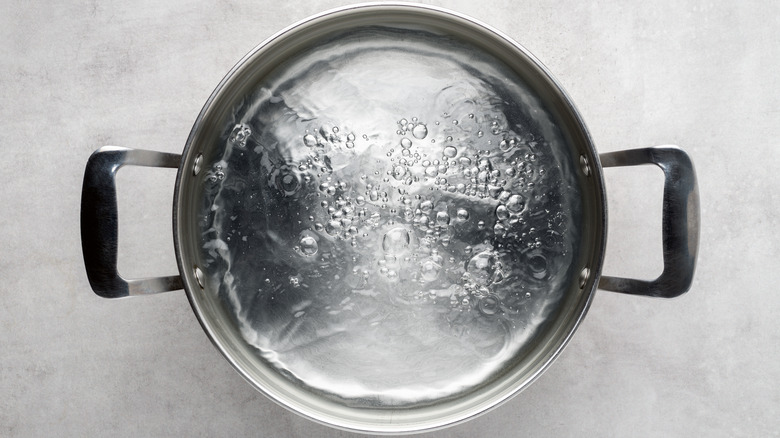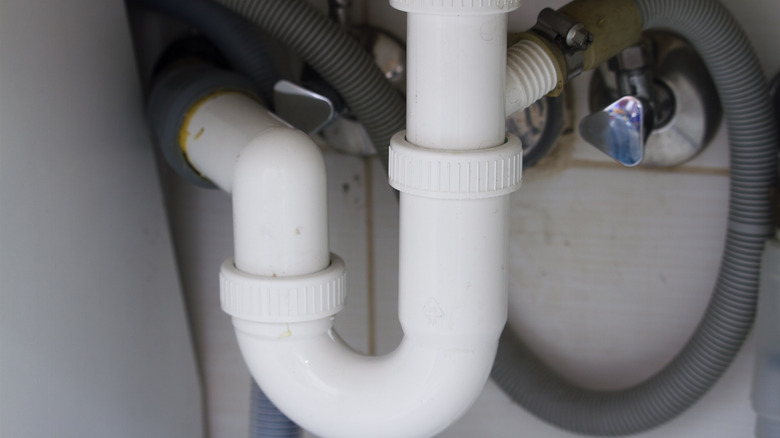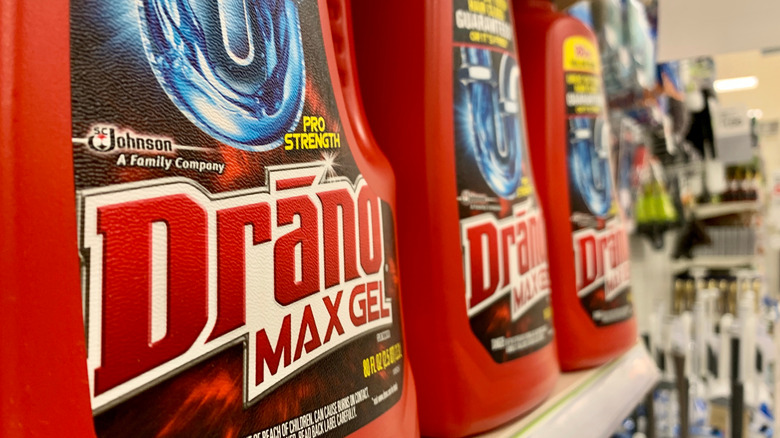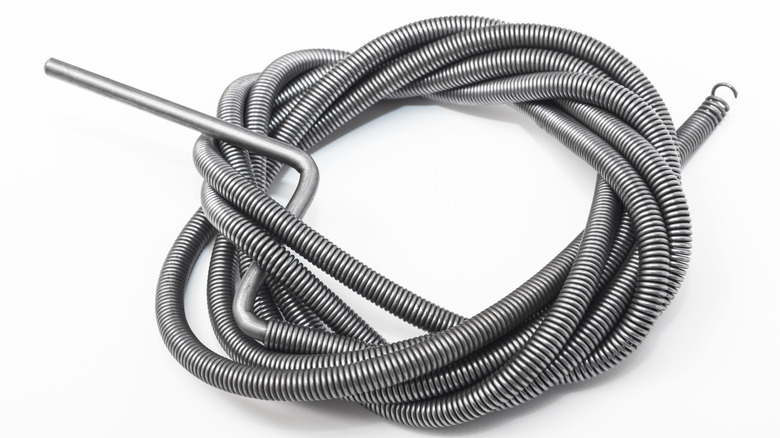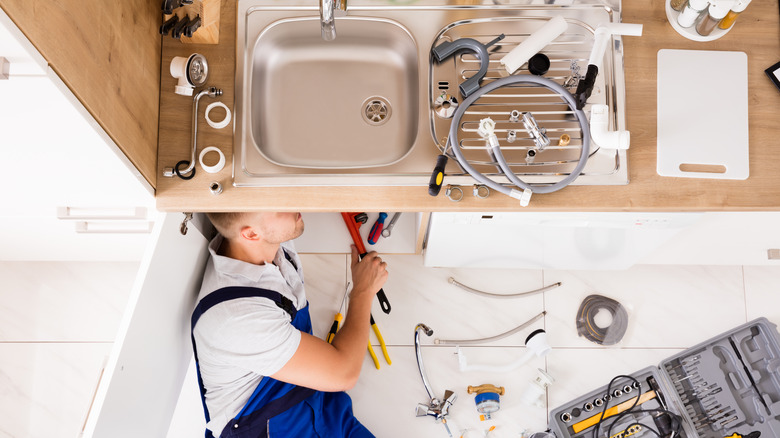10 Genius Tips For Unclogging The Kitchen Sink
We may receive a commission on purchases made from links.
A clogged sink can seemingly come out of nowhere, as well as at the most unfortunate of times, such as when you're about to have guests over for a dinner party. To that end, according to plumbing company Urban Piping, a clogged drain is most likely due to foreign objects, food, grease, coffee grounds, and/or eggshells. In other words, it's pretty much everything you want to avoid going down your drain. However, as with everything in life it can happen — but it doesn't have to put a damper on an entire evening.
The average unclogging of a kitchen sink, according to Fixr, is $150 to $500, going up to $1,350 for major mainline clogs. Additionally, there are different unclogging methods available, including a snake, electric snake, hydro jetting, and open pipe cleaning. Use these 10 genius tips for unclogging the kitchen sink, and you'll be back to enjoying your night in no time.
1. Prevention
Prevention is an excellent way to avoid having to unclog your sink. In an interview with The New York Times, Randy Pederson, the plumbing manager of Fox Service Company says, "Don't confuse the garbage disposal with the garbage can. It's really just for extra bits that come off of plates. If you're going to peel a pile of potatoes or cut up vegetables, put scraps in the trash." Then, of course, you'll want to avoid those other drain cloggers that we mention, including the coffee grounds, eggshells, grease, etc.
When it comes to your favorite beverage, Pratt Plumbing says to throw away coffee grounds or use the grounds as compost. They also advise placing grease in a tin so that it avoids going down the sink, and adding a drain cover that can trap food and stop it from clogging your drain. Affordable drain grates can also be purchased online, such as the Heavy Duty Stainless Steel Slop Basket Filter Trap for under $7.
2. Investigate the garbage disposal
Besides the list mentioned above, Bob Vila has a slew of items that should never make their way to garbage disposals. Some of these items include chicken bones and seafood shells. Bearing that in mind, you will want to check the garbage disposal because, according to The Spruce, a clogged garbage disposal can cause water to fill up your sink, citing a common culprit as the drain trap. The outlet also notes that this area can harbor food remnants and be the source of your clogged drain.
To fix the issue, go ahead and grab the following tools: bucket, channel-type pliers, scrub brush or wire, drain snake (if needed), and paper towels or rags. First, remove the p-trap, then clean it with a tiny but mighty scrub brush. Then, clean inside the trap arm, and snake the branch drain if necessary. Lastly, you will reassemble everything and then flush the drain.
3. Use a plunger
One crucial step you may want to try before putting things down the sink is to grab your plunger and see if that can do the trick. "If your drain is clogged or just not running as smoothly as it should, the first step is to use a drain plunger. Using a sink or toilet plunger, place over the clogged drain and give it a few pumps," says Lou Manfredini, the resident home expert of Ace Hardware, to Martha Stewert. "If it is a double sink in a kitchen, plug the drain on the opposite side so that when plunging, you are not forcing air out of the open drain but rather towards the clog."
Most often, using the plunger can loosen up any food or debris that has been lodged in the sink, making water flow easily down the drain. But, not all plungers suit every job. According to Bob Vila, there are an assortment of plungers suitable for different jobs. For a sink, a plunger in the shape of a cup would be the best option. Also, we think you should make sure to use a clean plunger as opposed to the one that resides next to your toilet.
4. Use a wet/dry vacuum
According to Home Depot, you could clear out a sink drain with a wet-dry vacuum if you're dealing with a clog. First, they advise that you look at the instructions provided and ensure that you place the vacuum on the wet use mode before trying this method.
As far as equipment goes, the Vacmaster Professional – Professional Wet/Dry Vac is an excellent choice for this method; however, be sure to remove the paper filter prior to attempting to dislodge any debris from your sink. One reviewer loved this vacuum, saying that they "purchased this to help unclog my kitchen pipes after cleaning out the p-trap didn't solve the issue, and poking around with coat hanger proved fruitless. ... My kitchen sink drains, life is back to normal, and I now have a powerful wet/dry vac I can use in the garage." That sounds like a promising endorsement.
5. Baking soda and vinegar
According to Hunker, the baking soda and vinegar method can work wonders on unclogging a kitchen sink. However, the outlet mentions that you should not try this method if you have just used a chemical-based store-bought product as there could be an adverse reaction, which you definitely don't want! So if this is your first go at trying to unclog the sink, have at this homemade mixture that several plumbers recommend.
Per Home Depot, first you will want to add 1 cup of baking soda to the drain. Next, they suggest that you add 1 cup of white vinegar to the sink. After that, they say to put a drain stopper on your sink and let the mixture rest for up to 15 minutes. After you have waited, it's time to remove the drain stopper and run the water to see if it has unclogged the sink.
6. Boiling water
For some clogs, pouring boiling water into the sink will do the trick. According to the cleaning service The Maids, you should bring up to 2 quarts of water to a boil. Then, they advise that you carefully pour the water down the sink's drain. Next, add 1 cup of baking soda to the drain and then turn on the sink's water for an excellent rinse. Hopefully by then you can see if this fixed the clog or not.
However, Gilmore Heating, Air, and Plumbing suggests that you do not pour boiling water down your sink pipes, especially if you have PVC pipes, as it could melt the pipes and any seals that are not metal. The company also says that the baking soda and vinegar solution that is often recommended for simpler clogs may not work for more serious clogs. They also recommend using a snake or plunger for more mild clogs.
7. Clean the p-trap
A p-trap full of gunk is one sure way to have either a slow drain or one that is entirely clogged. To that end, one of the things that Bob Vila suggests doing before calling a professional to come and take a look is to clean out the p-trap. This is the pipe under the sink that looks like an "elbow." First, add a bucket to ensure that water does not get everywhere during the process before you get started. Then you will unscrew the pivot nut, take out the stopper, clean out the pipe using a hand snake, and clean the stopper before you reassemble everything.
Additionally, Ivitts Plumbing says that it is not a bad idea to clean out the p-trap occasionally. Doing this every so often can help ward off future clogs since this pipe area is a haven for food particles and other debris, and prevention is one of our top tips for keeping your drains working properly.
8. Commercial products
If none of the above methods worked and you want to take a simpler route, you can purchase a product to help solve your clogged sink issues. For example, plenty of homeowners have had success with Drano Max Gel Drain Clog Remover, which is available on Amazon. It works for challenging, stubborn drains, with one reviewer even saying that it was a miraculous solution for them. "We had a clog problem in the kitchen sink for several days," they explained. "I called a plumber who tried the snake, but it didn't work. I just want to try this before removing all the pipes in the basement." Fortunately it worked for them.
If you are hesitant to try a chemical drain cleaner, there are other options; one natural product that Today recommends is the Earthworm Family Safe Drain Cleaner that has enzymes that can eat away at food particles and debris. It is also an excellent way to prevent clogs if added to your drain at least once a month.
9. Snake the drain
Having a professional snake your drain could run anywhere from $145 to $334, according to Home Advisor, so if the clog isn't severe, snaking your drain yourself can be an excellent way to remove a clog. However, if there are any damages to your pipes, your bill could be much higher.
According to Bob Vila, there are two types of plumber snakes, including a manual or electric version made of different materials, from cheap plastic to durable stainless steel. One popular plumber snake, Katzco Professional Slow Drain Cleaner and Clog Remover, was a success for one reviewer. "I bought this because one of the drains in my dual kitchen sink has been clogged up for a few days," they shared. "I found this and decided to give it a try. It worked awesomely. The length of this is pretty long, I didn't even need to put it all in completely to unclog it." They added that they were pleased with their purchase.
10. Hire a plumber
Sometimes you just need to bring in a professional plumber if you have tried all of these above methods and still aren't having luck with unclogging your sink's drain in time for that dinner party. There are times when the clog is too challenging, or a homeowner doesn't have the proper tools or understanding to do the job correctly.
Per Roto-Rooter, there are several reasons why your sink may be clogged, from grease accidentally being poured down the sink to a malfunctioning garbage disposal. If you don't have the know-how or the tools (or the time, for that matter), a pro can come in and finish the job quickly and efficiently.
Another vital tip to consider is that most professional plumbing companies have unique cameras to see exactly where the problem is located. Mr. Rooter Plumbing notes that there's no more damaging digging since these cameras take the guesswork out of the equation and know precisely where the problem is, which keeps repair costs at bay.
